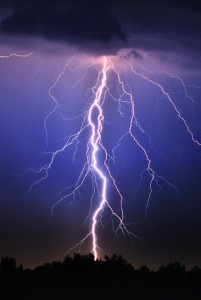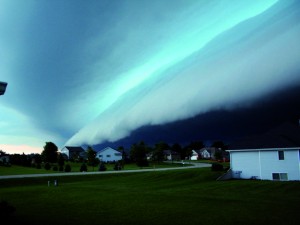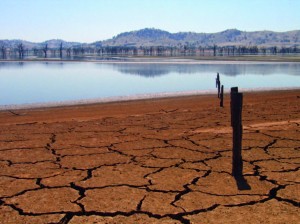MONDAY, 25 NOVEMBER 2013
The weather is a grand scheme of nature that influences almost every aspect of our lives. It determines our outdoor activities, how we dress and what we eat. Yet, it is more than our daily routine that is tangibly shaped by the direction of the weathervane arrow. The collapse of the once powerful Mayan civilisation and the fall of the Tang Dynasty can both be correlated with drought and famine, caused by changing weather patterns. In 1281, the naval invasion of Japan by the Mongols, the largest in history, was crippled by the Kamikaze winds. Encrypted weather reports included in German correspondence during World War II were exploited by the British to crack the Enigma code and give the Allies a significant advantage. More recently, hurricane Katrina flooded 80 per cent of New Orleans causing $150 billion worth of damage and 1800 casualties. Weather phenomena can also strike in implausible patterns: in 1998, lightning during a football match in Congo killed all 11 players of one team, leading to accusations of witchcraft by the other team. It is precisely this erratic nature of weather that makes it an ideal conversation starter.Humans have devised weather forecasts to protect life and property from such unfortunate occurrences, as well as plan our lives effectively. On the next few pages we shall explain why today’s forecasts are often so unreliable; we will discuss where the weather comes from, how it arises and what effect it has on us. We will see how lightning storms and hurricanes come about, how the climate can change the fate of us all and why we feel gloomy on a rainy day. More importantly, we will ask ourselves: will we ever be able to manipulate the weather? But first, let us try to explain why you simply cannot trust the weatherman.
The weather on Earth is extremely complex and it is impressive enough that we can follow the constantly changing patterns, let alone anticipate them. For centuries, humans have depended on rules of thumb to predict weather changes. For instance, closed pinecone scales or certain animal behaviours indicate that rain is on the way. It was not until 1922 that the publication of Weather Prediction by Numerical Process set out scientific methods that form the basis of weather forecasting to this day. The first stage of this process involves collecting enormous sets of data, such as atmospheric pressure, temperature, humidity, precipitation and wind speed. This is done by trained observers, automatic weather stations (such as the one 26,000 feet up on Mount Everest) and buoys strategically positioned all over the world or by orbiting satellites. The gathered data is then fed into mathematical models incorporating physics and fluid dynamics equations in order to model the initial state of the atmosphere and generate a forecast of how it might change in the future. Handling the vast amounts of data and performing the trillions of complex calculations requires some of the most powerful supercomputers in the world— the Met Office uses a machine with the computing power of 20,000 ordinary PCs.
Despite the tremendous advances in meteorology, the chaotic nature and incomplete understanding of the underlying processes mean that predictions become less accurate as the forecasting range increases. Even the most sophisticated models oversimplify the real state of the atmosphere and tiny changes can have huge domino effects. As mathematician and meteorologist Edward Lorenzo eloquently put it, “does the flap of a butterfly’s wings in Brazil cause a tornado in Texas?” The ‘stochastic method’ of weather prediction accounts for this uncertainty by running the forecast multiple times using slightly altered initial conditions, such as a change of 1°C in temperature or a percentage point in humidity. The most statistically probable predictions are then further scrutinised by experts. Meteorologists are constantly trying to improve forecasting methods and lengthen warning times for natural disasters like tornadoes and hurricanes.
That’s all well and good, but just what exactly does it mean when the weatherman talks about ‘low or high pressure’, ‘precipitation’, ‘humidity’—and what is their connection to the majestic plethora of weather phenomena we experience? Moreover, what underlies the perpetual change in weather? Before we address these questions we need to examine the basics of how the weather works.
For the most part, weather on Earth occurs due to the uneven distribution of solar energy between locations; the closer to the equator, the larger the Sun angle and the warmer the temperatures. The air above hot surfaces heats and expands, resulting in lower air pressure. In low pressure systems, the warm humid air rises up and when it reaches the (cooler) higher altitudes it releases water vapour, because cool air cannot hold as much moisture. The vapour then condenses around tiny particles, such as dust, into visible clouds of water droplets or ice crystals. Cumulonimbus clouds—the ones responsible for storms—can typically form in under an hour and contain millions of tons of water. As this process carries on, the water droplets become too heavy to be supported by the updraughts of air and leave the cloud in the form of precipitation. Precipitation falls as snow when the air temperature is below 2°C. If the temperature is slightly warmer, the snowflake will melt and fall as sleet. If it is warmer still, it will be rain.
As air moves upwards, wind rushes in to fill the gap. Therefore, the temperature gradient also drives winds moving from areas of high to low pressure. For instance, sea breezes occur because heat from the Sun warms the land much quicker than the sea. On a larger scale, the high temperature contrast between the poles and the tropics gives rise to very strong winds high up in the atmosphere, called jet streams, and large ocean currents. Weather in the UK is affected by the Gulf Stream, which transfers warm Atlantic water and air northeast towards the western coast of Europe. As all this moist air sweeps across the country it is forced over hills and mountains, where it often precipitates to rain.
While wind, rain and snow might be annoying and even dangerous or damaging, nature’s real power becomes evident in more extreme conditions, such as lightning storms and hurricanes. After all, at 30,000°C, a lightning bolt is hotter than the surface of the Sun and carries enough electricity to light a 100 watt light bulb for three months. Lightning is caused by precipitation that moves within the cloud, rubbing against smaller ice crystals and thereby acquiring a negative charge that accumulates at the base of the cloud. The negative charge then seeks out the shortest route to something with a positive charge to balance itself out. When a recipient is found (a tree, a tall building or—if unlucky—a person), the discharging flash of lightning travels through the air at an astonishing 120 kilometres per second. The accompanying sound of thunder is caused by the shockwave produced by the sudden air expansion due to the increase in temperature around the lightning bolt. The distance of lightning can be calculated by the time interval between the flash and the thunder; every 2.9 seconds that elapse translate into approximately one kilometre distance. Despite the forceful nature of this phenomenon, lightning is not always deadly; Roy Sullivan, a ranger in a USA national park was struck seven times, yet only suffered minor injuries.
Tropical storms such as hurricanes occur in areas of very low pressure, typically within 8° and 15° of the equator, where surface sea temperatures reach 27°C. The air above the warm water is heated and rises, forming huge clouds, while strong winds rush in to fill the gap, creating a spiral. In essence, hurricanes use the warm water as a power source, which is why they die out over land. The radius of a hurricane is usually around 50 kilometres, but can sometimes reach more than 300 kilometres—in any case, weather in the eye of the storm is always calm. While it is going strong, a hurricane can within ten minutes release more energy than all the world’s nuclear weapons combined. Accordingly, it is estimated that hurricanes have led to the death of over 2 million people over the last 200 years.
The dynamic nature of weather formation leads to a quite remarkable breadth of conditions on Earth. The highest recorded temperature was a sweltering 58°C in Libya, while the lowest was a bitter -89.6°C in Antarctica. Eleven metres of annual rainfall makes India the wettest place on Earth, while you would have to wait a century to fill up a cup in the dry Chilean desert. Conditions can also change rather quickly; on January 1943, appropriately named Rapid City in South Dakota saw the temperature rise from -20°C to 7°C within just two minutes. Although this variant nature of weather often prompts us to complain it’s ‘too hot’, ‘too cold’, or ‘too windy’, when we consider weather patterns on other planets we can see that we truly have the better deal on Earth.
Mercury, for example, is much closer to the Sun and has a very thin atmosphere that cannot retain solar heat the way Earth can. These two factors lead to the most extreme variations in the solar system, with surface temperatures ranging from -184°C at night to 430°C during the day—if a human being was to be exposed to these conditions they would either be frozen hard as rock or burst into flames in a nanosecond. Mars has a very complex weather system caused by the interaction between its solid CO2 polar ice caps and the atmospheric CO2. When one pole is in winter and pointing away from the Sun, the cap expands as atmospheric CO2 freezes into dry ice, while the Sun-facing cap melts to release CO2 to the atmosphere. In the end, the unequal amounts of CO2 exchanged between poles over the year generate massive changes in temperature and atmospheric pressure, generating enormous sand storms.
The gas giants Jupiter, Saturn, Uranus and Neptune, which are not primarily composed of solid matter, feature even more extreme weather due to their dense atmospheres. The Great Red Spot of Jupiter is in fact an immense storm that has been raging for the past 300 years, with winds reaching 400 kilometres per hour. Still, these winds are a gentle breeze compared to the ones on Neptune, where the lack of a surface allows speeds of more than 2500 kilometres per hour. This poses a puzzle for planetary scientists, because the solar energy reaching Neptune is only 1 ⁄ 900th of that received by Earth—yet the intensity of weather phenomena is far greater. On Uranus, the extreme axial tilt of the planet (98°) leads to decade long winters; when parts of the planet finally emerge from winter, gigantic springtime storms roughly the size of North America are triggered.
Coming back to Earth, how does the weather that we experience influence human life? Surely it goes further than determining what we wear and how we spend our time? To address this question, we have to look beyond daily weather fluctuations. Slow changes in dynamic variables, such as vegetation coverage or the quantity of atmospheric greenhouse gases, modify the weather over longer periods of time. These so-called climate shifts have shaped human progress throughout history: civilisations have risen and fallen; wars have broken out and disease has spread; settlements have been established and ideas formed. By understanding the impact of climate, researchers have been able to reconstruct certain historical events. For instance, warfare, population growth and dynastic upheaval in China were closely associated with notably cold periods, particularly in the 17th and early 19th centuries when crops failed and prices increased. Populations responded to this stress by defending their limited resources, which often led to stealing, conflict and political unrest. Many migrated, leading to wars as one group tried to displace another. Such mass migrations also facilitated the spread of disease and created several epidemics. It is thought that the spread of the bubonic plague in the 1300s, which saw the death of 25-33 per cent of Europeans, was assisted by increased migration brought about by the coldest weather in several hundred years.
Even in today’s modern world, Earth’s climate significantly influences human populations. Much of the unrest encountered in the Horn of Africa can be linked to erratic weather. Recent climate changes have caused the displacement of over one million inhabitants of Kenya and Somalia, with an additional 150,000 to 300,000 at risk of starvation. Even a 0.5 ̊C annual increase in temperature sees crop yields decrease by up to 30 per cent, leading to limited resources and conflict. In fact, research has shown that conflict is up to 50 per cent higher in years that are only 1 ̊C warmer. This is worrying because given that average temperatures are estimated to rise by 0.2-0.5 ̊C per decade in Africa, there could be a 50 per cent increase in conflict by 2030.
The El Niño phenomenon, an abnormal warming of surface ocean waters in the eastern tropical Pacific, causes extreme weather which hampers agriculture and fishing yields, leading to economic contraction and unrest across the region. Solomon Hsiang and his team found that in El Niño years, the risk of civil war in tropical countries doubled—this means that the phenomenon has potentially influenced 20 per cent of civil wars since 1950. The random and rapid onset of El Niño makes it hard to combat its devastating effects. Although we still do not fully understand its origin, modern computer models can predict occurrences up to two years in advance. Hopefully, governments and aid groups will soon use this technology to help combat the upheaval associated with El Niño and other erratic weather patterns. Given the body of evidence highlighting our political and social fragility at the hands of the weather, it is imperative to prepare for its effects.
But how does each of us individually come into the big weather picture? Even when following regular patterns, seasonal changes still affect our well-being. Perhaps the most illustrative example is the common cold. As the name implies, catching a cold has long been associated with cold weather, based mostly on empirical evidence. A study has indeed found a 19 per cent increase in the frequency of consultations for lower respiratory tract infections for every 1°C drop below 5°C. One popular explanation is that host immunity is compromised in the cold. For instance, the constriction of blood vessels, a mechanism reducing blood flow to the body surface in order to conserve heat in cold environments, also diminishes immune cell delivery to the respiratory tract. Scientists believe that breathing in colder air chills the upper airways and allows rhinoviruses that cause the common cold to flourish; indeed, when rhinovirus-infected airway cells from mice were grown under cold conditions they were less likely to be eliminated via a process of regulated cell death. Besides a weakening in our defense capabilities, the increased infection rates in cold weather could also be explained by an enhancement in infectious agent transmission. For example, changes in humidity may affect the amount of air-borne viruses contained in the air. Some researchers have also pointed out that cold weather can indirectly foster pathogen transmission by increasing the time we spend at close proximity with other people indoors.
“Rainy days and Mondays always get me down”. The popular saying implies an effect of weather fluctuations on human psychology, however the scientific evidence for this remains controversial. Some early research reported a link between weather and mood but this could not be confirmed by subsequent studies. Interestingly, a 10 year-long study in England and Wales showed that each 1°C increase in temperature above 18°C is accompanied by a 5 per cent increase in suicidal rate, an effect attributed to variations in serotonin—a hormone linked to depression—or increased alcohol consumption due to thirst. A greater consensus on a causal relationship between weather and mood is seen in Seasonal Affective Disorder (SAD), a syndrome in which patients feel low during winter. Although this condition is not well understood, it is thought that low light availability is a key factor. The amount of sunlight influences the number of nerve messages sent from the eyes to certain parts of the brain and in turn affects levels of mood-controlling chemicals and hormones. Indeed, SAD has been linked to mutations in melanopsin—a photopigment found in the eye retina—which is involved in fine-tuning the body clock according to daylight hours. It has even been proposed that the tendency for low mood and inactivity during SAD may be an evolutionary remnant to reduce energy consumption, similar to winter hibernation when food is scarce.
Knowing how intricately the weather affects our welfare, could we not go one step further and control the weather to create favourable conditions, improve public health or preclude disasters? Although this idea verges on science fiction territory, weather manipulations have actually been attempted repeatedly throughout history. The most widely used weather modification is ‘cloud seeding’, a technique to enhance precipitation in existing clouds—in other words, to make them rain out. The first demonstration came from the Schaefer-Langmuir experiments in the 1950s: seeding clouds with grains of dry ice caused water to condense and form crystals, which then fell as precipitation. Today, a more common method is to deliver silver iodide into clouds with airplanes or special artillery. Cloud seeding has been used to increase rain in drought-prone countries like the US, India, Russia and China. Applications also include reducing fog over airports, increasing snowpack in mountainous regions and even ‘washing the air’ in heavily polluted areas. In 2008, cloud seeding was implemented in Beijing to prevent rainfall during the Olympic Games ceremonies.
Naturally, weather interference has also been explored as a tactic to prevent more extreme phenomena, such as hurricanes. Ideas include pouring liquid nitrogen onto the warm sea surface or mixing it with the cooler water below to deprive the storm of heat energy, or seeding storm clouds with a water-absorbing polyacrylic acid derivative. The most ambitious plans implement a space-based solar power network to ameliorate hurricanes via heating with microwaves. Unfortunately, there is little scientific evidence to confirm the effectiveness of these manipulations at present, so the thought of flipping a switch to instantly produce rainbows is still a long way off.
According to the National Oceanic and Atmospheric Administration, weather in 2012 was the hottest and second most extreme in recorded US history. It is increasingly evident that we are in the middle of another climate change, attributed mainly to human activity but also to natural causes. The most pessimistic estimations by the Intergovernmental Panel on Climate Change warn of imminent and disastrous changes, such as a 6.4 ̊C rise in global surface temperature by 2100, calling for immediate regulatory action. Knowing the effects climate can have on whole populations as well as individuals, it will be interesting to see how this climate change may affect humanity and what challenges we might face in the future. Nevertheless, we should keep in mind that weather forecasting is never straightforward, reflecting our inadequate understanding of the underlying processes. What is certain is that humans will continue to indulge in, explore and adapt to these mysterious phenomena around us—whatever the weather.
Yvonne Collins is a 3rd year PhD student at the Mitochondrial Biology Unit (MBU)
Matthew Dunstan is a 3rd year PhD student at the Department of Chemistry
Martha Stokes is a 3rd year Natural Sciences student at the Zoology Department
Theodosia Woo is a Natural Sciences exchange student at Emmanuel College











